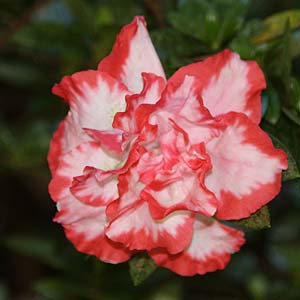
Despite the long list of problems listed Azaleas are actually relatively easy to care for and for the most part are disease and pest free. A healthy environment is the key to preventing diseases, insect and fungal problems. Good air flow, healthy soil, correct soil Ph are all good starting points for healthy plants. We list some of the common diseases and problems of Azaleas and provide some ideas about prevention.
And yes there are different types of, Azalea Indica hybrids, Kurume hybrids, Mollis hybrids (deciduous)
Lace Bug – Black Spots on Azalea Leaves
One of the most common problems with azaleas is the ‘black spots’ that appear on the foliage. Wonderful flowers but sick looking foliage is not the best look, so what causes Azalea foliage to look so untidy?
In many cases it is Lace Bug, you can barely see them, but if you take the time to look at the underside of the foliage you can see little black spots. Lace bugs attack new foliage and they like to hide under the leaves, it gives them a little protection from the elements and the underside if the leaf is more tender for these little sap sucking insects.
A number of methods of control are available including the usual organic ‘knock down’ sprays. However Lace Bugs lay eggs that hatch over a long period so any knock down spray would need to be applied fairly often.
A systemic treatment has longer lasting effects, these work by the plant absorbing the the chemical and the insects then absorb it back when they start on the new foliage. A few brands exist, Confidor is one.
Best time to spray is in late winter to early spring when the Lace Bugs are at their busiest. If you have a sever problem then a follow up in summer and autumn might be required.
You can also make sure that the Azalea are well fed and happy at the same time, we like to water with a liquid seaweed fertilizer at least three times from spring to autumn. A little specialist azalea food in the form of a slow release pellet will also help. Mulch well to keep the root run cool.
Azalea Lace Bug is a common problem. Remember that old foliage will not recover, you will have to wait for new growth for those azaleas to loose those black spots.
Other Azalea Problems
Rust – Yellow Markings on Azaleas
If the foliage looks,’Rusty’, yellow to orange / red markings then you have Azalea Rust. For this one check the soil conditions, Dry, Wrong Ph, Low on nutrients then your Azalea is stressed and probably has a fungal disease. Look for a fungicide at your local nursery.
Powdery Mildew
If the foliage is covered in a white ‘powdery’ fungus, you probably have powdery mildew. Often caused by poor air circulation and humidity. The long term solution is to plant azaleas where they get good air circulation, this is especially true in warmer, humid climates. A fungicidal spray is the quick solution
Flowers Dropping Off Azaleas
If the flowers on azaleas are turning brown and dropping off early on, then you have a different fungal problem, ‘petal blight’. Its a fungus that just affects the flowers. As for many fungus diseases prevention is best, provide good air circulation and a healthy environment. Remove and clean up infected petals and dispose of by burning or in waste collection ( no point in composting diseased material). You can spray with a fungicide for immediate effect if required
Swelling in the leaf.
This is probably ‘Leaf Gall’, simply remove and dispose of the infected material.
Petal Blight
Another fungal disease caused by poor air circulation and humidity, the petals will turn brown, often just as they are about to open.
Other problems include: Thrips, White Fly, and Leaf Curling Caterpillars. Neem Oil is a good solution to these problems.
You may also like
- azalea care
- mollis azaleas – the deciduous azalea
- white azaleas
- fertilizing azaleas
- azaleas for sale online
- soil ph
- rhododendrons
- rose care
Other problems include.
- poor drainage
- too much sun
- frost
- too much shade
More information
Azaleas are fairly shallow rooted, so if you need to adjust the ph you do not really need to dig to deeply. You are looking for a ph 4- 5.5, this is ideal, but azaleas are actually a little more tolerant than that. Often Azalea fertilizer if applied on a regular basis will be enough to bring the ph into an acceptable range. Some mulches will push up the ph so be careful here. More information on soil ph
Plant Azaleas in a semi shaded position in a well drained, humus rich soil, check with the nursery as some species and cultivars are more sun tolerant than others.
